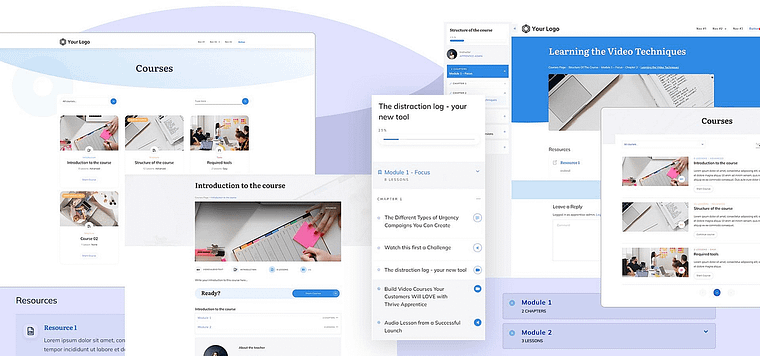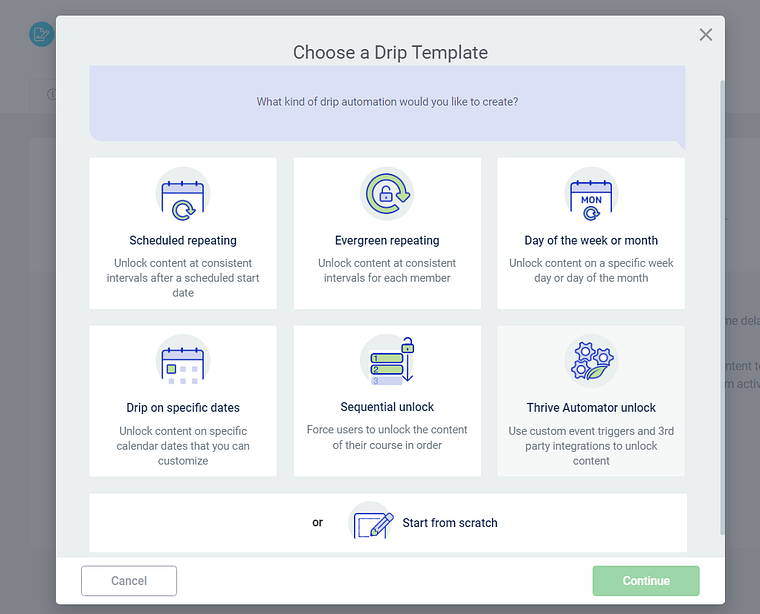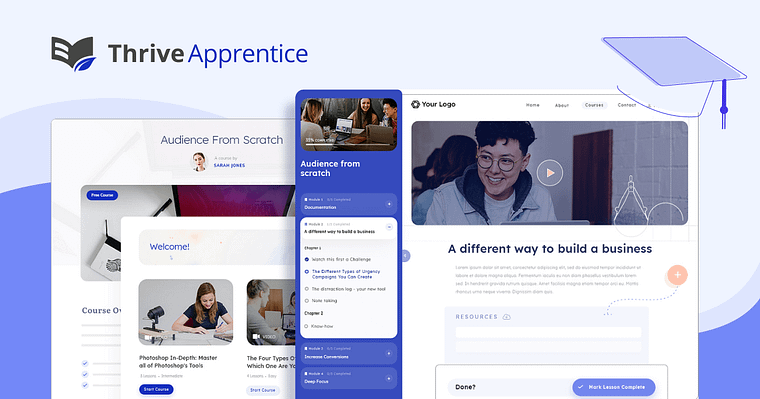Want to learn how to increase student retention for your online courses?
You’ve come to the right guide.
I’ve helped create my fair share of courses over the years, and let me tell you: I’ve made a few mistakes along the way.
But, fortunately, those mistakes helped me find solid ways to create content that was actually valuable and engaging.
Not only that, but in my freelancer days, I managed to help improve my clients’ online course completion rates.
And today, I’m going to share 11 tips to help improve yours.
How to Get Your Students to Start and Finish Your Courses
A mistake I’ve seen a lot of new course creators make is think the sale is the main goal.
While that is the focus – getting people to purchase your course – there’s still more ahead. If you really care about your work and students, you’ll want to see them take and finish your course.
But it isn’t as straightforward as you think. Your students are faced with a lot of distractions – life challenges, work, other courses, etc.
You need to make your course stand out from the noise.
And it’s actually quite easy to do this. So easy, a lot of other course creators miss it.
You see, you don’t need to be a magician to keep your students’ attention. You just need to show them you care about their progress and you want your content to help them achieve their desired level of success.
This tutorial will show you how.
11 Tips to Help You Retain More Online Course Students
1. Set Clear Expectations from the Start
Before I buy a course, I always take a look at the curriculum and “What Can You Expect” section of the creator’s landing page.
I like to know what I’m getting myself into before going through with a purchase – and there’s a high chance your potential learners are like me.
Setting clear expectations from the get-go gives your students a roadmap they can follow. It clears any questions they may have about your course content and helps them know what they’re in for.
By the time they press “buy”, they’re making an informed decision – making them much likelier to see the course through.
Think about it – if you know what you're working towards and how you're going to get there, you're more likely to stick with it, right
Start by creating a detailed syllabus that covers all the bases.
Don’t vaguely list out the topics in your course. Offer a breakdown that includes a mini synopsis of each module and lesson.
Expand on your learning objectives, week by week if possible, so students can see their progress unfold.
Next, add an explainer video to your landing page that provides a brief overview of your course. In fact, I’d suggest going a step further and adding an introductory video to your course funnel’s thank you page.
You’re achieving multiple things with this step – you’re making your new students feel welcome, providing them with actionable next steps, and helping alleviate any uncertainties they may have about the course they’ve just purchased.
2. Use the Right Tools to Offer a Memorable Learning Experience
When I think of all the online courses I’ve completed (and they’re quite a lot), I can find a few common factors among them:
The lessons were well organized
There was a variety in the course materials
The course platform was easy to navigate
And to create this kind of experience for your students, you need to use the right tools.
My recommendation? Thrive Apprentice.
This powerful LMS plugin not only includes this essential feature but also provides a suite of tools to help you create a high-quality, engaging, and informative online classroom—all at an affordable price with no need for expensive add-ons. It’s truly “your course, your way” and on a budget, too.
Here’s Why You'll Love Thrive Apprentice
Easy Setup for Quick Building
Say goodbye to complicated setups and hello to the Thrive Apprentice setup wizard. No coding skills? No problem! Whether you’re a WordPress beginner or a technical expert, this is the perfect tool for you.

Your Course, Your Way
With Thrive Apprentice, you're the boss. Host your entire course right on your WordPress site, giving you complete control over its look and feel.
Whether you want to have on-demand courses, asynchronous lessons, or even cohort-based sessions, you get to build your platform your way.
Your learners will love the seamless, professional experience from the moment they enroll to the final celebration of their success. And you get to keep all your course sales — we don’t take a single cut!
Brand It Like a Pro
Want to make your course stand out?
Thrive Apprentice's got you covered with customizable templates that you can tweak to perfection. With just a click, you can change colors to match your brand, creating a visually stunning course that's uniquely yours.

Engage and Delight Your Learners
Want to keep your learners coming back for more? Thrive Apprentice has got your back with interactive features that'll make your course a blast.
From assessments that test their knowledge to certificates that celebrate their achievements, your learners will be driven to finish your course.

And here's the best part: with personalized course completion pages, you can not only make your learners feel like superstars, but also guide them towards their next steps. It's the perfect opportunity to promote your other courses or products, keeping them engaged and hungry for more!
Use a WordPress course building plugin like Thrive Apprentice to design a customized course completion page for your learners.
Stay Organized At All Times
Nobody likes a course that feels like a maze. With Thrive Apprentice, you can keep your learners focused and motivated with features like drip content, access restrictions, and the all-important minimum watch time.
You won’t find all these features in another course-building plugin on WordPress.org or WordPress.com – and for the same price as what Thrive Apprentice offers.
Once you get this plugin, you get everything you need. No free version with limiting features. No expensive add-ons.
3. Create a Supportive Onboarding Process
Think back to the last time you joined a new gym or started a new job. Remember that slightly lost feeling? That's how many of your students feel when they first log into your course.
A smooth onboarding process can help your learners find their way. It makes all the difference between feeling overwhelmed and feeling excited to dive in.
A good start helps students stick with the course. When they feel welcome and know what to do from day one, they're more likely to stay engaged. This early support makes a big difference in keeping students on board, especially when things get tough later on. It's all about making them feel at home in your online classroom from the beginning.
Start with a friendly welcome email as soon as someone signs up. Tell them a bit about yourself and why your course is great. Give them a taste of what's coming up. Then, make a simple guide to show them around your course website. You could use short videos or step-by-step instructions to show how things work. Cover the basics like finding lessons, turning in homework, and talking to other students.
Come up with an easy first task to get everyone involved. It could be something fun like sharing a fun fact about themselves in a discussion, or a quick quiz to show them how tests will work.
Make sure they know where to get help if they need it. Write down clear steps for getting tech support or asking you questions. If possible, you could pair up new students with ones who've taken the course before, so they have a buddy to turn to.
When you take the time to welcome your students properly, they're more likely to jump in with both feet and stick around.
4. Use Interactive and Varied Content
When it comes to learning, I love variety. While I mainly prefer to read content and learn on my own, I’ve also found value in using visual aids and even audio.
Mixing up how you teach keeps things interesting. When students have different ways to learn, they're more likely to stay focused and enjoy the course.
Some people learn best by watching, others by doing, and some by playing games. When you offer a bit of everything, you're giving each student a chance to shine.
I recommend breaking up your lessons into different types of content. Use short videos to explain tricky concepts – aim for around 5-10 minutes to keep attention high. After each video, throw in a quick quiz to help students check if they've got it. These quizzes don't have to be for grades; they could be more like checkpoints to boost confidence.
Try adding some hands-on exercises where students can practice what they've learned. This could be a simple simulation, a virtual lab, or a problem-solving task. The key is to get them doing, not just watching or reading.
Improve Learning Retention with Assessments
Course assessments really help students remember what they're learning. When you know you'll be tested on something, you pay more attention to it. Good assessments don't just ask you to repeat facts.
They get you to use what you've learned in real ways. This helps the information stick in your brain better. Assessments also show you what you know well and what you need to work on. This helps you study smarter.
When you do well on a quiz or finish a tough project, it feels good. This feeling keeps you motivated to keep going with the course. Basically, good assessments turn just reading or watching videos into really learning and remembering.
And you can use this tutorial to easily set up assessments in WordPress.
For your main tests or projects, think beyond just essays or multiple-choice questions. How about a video presentation, a podcast episode, or a mock client pitch? These kinds of assessments test knowledge and also build real-world skills.
And, of course, space things out. Don't dump all the videos in one section and all the quizzes in another.
Weave different types of content throughout each module to keep your students on their toes. That way, the learning experience feels fresh and exciting from start to finish.
5. Implement Drip Content to Maintain Momentum
Can you imagine if someone came to your door and dumped three months worth of learning in your arms and told you, “Here, get learning!”
Sometimes, offering all your course content in one go can feel this way – super overwhelming.
Enter: dripping course content.
Dripping content bit by bit keeps students from feeling swamped.
It's a way to keep them engaged regularly without dumping everything on them at once.
This method helps students stay focused on one part at a time which, in turn, makes the whole course feel more manageable. It also gives them something to look forward to, which keeps them coming back for more.
First, you need to break your course into clear chunks. Each “piece” should cover one main topic or skill. Then, decide how often you want to release new stuff. Once a week is pretty common, but you know your students best.
Use your course platform to set up automatic releases. If you’re using Thrive Apprentice, you get a variety of drip options – you can even create your own custom schedule.

If you aren’t familiar with using this feature, you can use this tutorial right here.
And make sure to tell your students about this setup from the start. Let them know when to expect new material so they can plan their study time.
Send out friendly reminder emails when new content drops. These can go out just before or on the day of each release. Keep these emails short and upbeat. Maybe give a sneak peek of what's coming to get them excited.
The key is to create a steady flow of content. Your students should start looking forward to new releases. Taking your course should become a part of their routine so they feel a need to see the whole thing through. Just remember to keep the pace right – not too slow that they lose interest, and not too fast that they feel overwhelmed.
6. Foster a Strong Sense of Community
I never used to join the online communities for the courses I’d take. I felt it was unnecessary.
“I’m here to learn, not interact in a group.”
Until I caved one day and joined the Facebook group of a popular writing course I’d signed up for – and I was blown away. The information shared by the course creator and other course takers was golden! Stuff I wouldn’t have picked up from the actual material.
Since then? I join every group attached to the courses I take.
When students feel like they're part of a group, they're more likely to stick around. It turns online learning into something more social and less lonely . When you've got classmates to chat with and learn from, it's easier to stay motivated.
You have a few options here.
You could create a Facebook group for your members and engage with them from time to time. Or, set up a lively discussion board on a platform like Reddit.
Alternatively, you could use a tool like MemberPress or Thrive Apprentice to set up your own membership platform and provide exclusive content in addition to your online courses.
Your options are endless.
The goal is to create a friendly, supportive vibe where everyone feels comfortable chipping in. When students know they've got a whole group behind them, they're more likely to stick with the course, even when it gets tough.
7. Provide Regular Feedback and Support
Imagine taking a set of assessments, only to never receive any feedback on your progress?
How are you supposed to improve? How do you correct your mistakes?
That’s a similar feeling your students may feel if they go through your entire course and never receive any feedback on their work.
Students want to know how they're doing. When they get feedback often, it helps them stay on track and feel like someone's paying attention. It's like having a coach cheering you on – it keeps you motivated and helps you improve.
Start by giving personal comments on homework and projects. Don't just say "good job" or "needs work." Tell them what they did well and where they can do better. Try to get this feedback to them pretty quickly – within a week is good.
When students ask questions, try to answer them fast. Even if you can't give a full answer right away, let them know you've seen their question and when you'll get back to them.
Keep students in the loop about how they're doing overall. You could send out progress reports every few weeks. These don't have to be fancy – just a quick note about what they've accomplished and what's coming up next.
Set up some automatic emails to check in on students who might be falling behind. If someone hasn't logged in for a while or missed an assignment, send them a friendly message to see if they need help.
8. Recognize and Reward Progress
Do you remember that feeling you got, as a kid, when your teacher put a gold star on your homework?
It felt great, right? Well, turns out we don't really outgrow that feeling.
As a course creator, it’s easy to get so focused on delivering content that you forget to celebrate your students' wins along the way. But those little moments of recognition can be rocket fuel for motivation.
People like to know they're doing well. When you notice and reward their hard work, it gives them a boost to keep going. And it’s more than a pat on the back. Acknowledging your students’ progress shows them you’re mindful of their participation – and that matters to them.
Set up a system of badges or certificates for hitting key milestones in the course.
In Thrive Apprentice, you can create personalized certificates easily. These certificates are fully customizable, so you can make them as unique as you want (but you’ll also need access to Thrive Architect, our landing page builder).
In addition to certificates, you could post shoutouts in the course or send out a quick congrats email. Just a simple "Great job on that last project!" can go a long way.
9. Offer Flexible Learning Paths
I’m a slow learner. I like to take my time and really take in all the information before hitting “next lesson”.
But, not every learner is like me. Some prefer to have their content dripped on a timely basis. While others might want to take all the course content in one go and finish it in a weekend.
If you have the chance to, try to offer flexible learning paths to accommodate different learning styles.
People learn differently and have various goals. When you give students some choice in how they learn, they're more likely to stick around. It's about making the course fit their needs, not the other way around.
There are a few ways to do this.
You could set up different release schedules based on your students’ preference. Or, offer a dripped and non-dripped version of your course and make it clear in your advertising.
This is a good way to give students control over their pace. Some might want to zip through, while others need more time. As long as there's a final deadline, let them move at a speed that works for them.
Include a mix of must-do and optional assignments. This way, students can focus on what's most relevant to their goals while still covering the essentials.
10. Use Your Analytics to Spot At-Risk Students
Ever had a student suddenly drop off the radar, only to find out weeks later they were struggling? It's a common scenario, but one that's largely preventable with the right approach.
When it comes to online learning, instructors don't have the luxury of reading a student's body language or noticing when they're zoning out in class. But you do have something just as powerful: data.
Catching problems early can make a big difference. When you notice a student might be struggling, you can step in and help before they give up. Think of it as having an early warning system for your course.
First, get familiar with the analytics tools in your course platform.
Thrive Apprentice provides in-depth reporting that you can easily find in the plugin’s dashboard.
Here, you can track course progress and identify where students are dropping off.
This is where you can look for warning signs. Maybe a student hasn't logged in for a while, or they're falling behind on assignments. Or their quiz scores might be dropping. These could all mean they're having trouble.
When you spot these signs, reach out. Send a friendly email checking in. Ask if they're having any problems with the course and offer some help. Maybe they just need a bit of extra explanation on a tough topic.
If your students know you're paying attention and want to help, they're more likely to push through tough spots instead of giving up.
11. Collect Student Feedback Often
Ever bought something online and immediately got a "How was your experience?" email? That's because smart companies know feedback is gold. And guess what? It's just as valuable for your online course.
Think about it - your students are the ones actually going through your course. They're seeing it from angles you might miss. Their insights could help in a big way.
Regularly asking for feedback does two awesome things: it helps you make your course better, and it shows your students you actually care what they think. When people feel heard, they're way more likely to stick around and stay engaged.
They see this gesture as you saying, "Hey, we're in this together. Let's make this course amazing." And who doesn't want to be part of something like that?
Set up a quick survey at a couple of key points in your course – after the first third of your course and at the end of it, for example.
Maybe do a short check-in after each module or every few weeks. Keep it simple – ask what they're enjoying and what they're finding tough.
More importantly, pay attention to what your students are saying in discussion forums or emails, too. Sometimes the best feedback comes from casual comments.
When you get feedback, show students you're listening. If a lot of people are struggling with a certain topic, add some extra resources or rework that section. If there's a feature of the course they really like, think about how you can do more of that.
Don't just focus on the negative stuff. Ask what's going well, too, so you know what to keep doing.
The main thing is to make students feel like partners in improving the course. When they see their input making a difference, they're more invested in sticking around and doing well.
It Pays to Go the Extra Mile
Look, I get it. Creating a course is hard work. After pouring your heart and soul into the content, it's tempting to sit back and let the sales roll in. But here's the truth: the real magic happens when you go beyond the sale.
Remember, your course isn't just a product – it's a promise. A promise to help your students transform, learn, and grow. And when you fulfill that promise, amazing things happen.
Students who complete your course are more likely to leave glowing reviews, recommend you to friends, and come back for more. They become your biggest fans and most powerful marketing tool. And let's be honest, there's no better feeling than knowing you've made a real difference in someone's life or career.
Remember, your success as a course creator isn't measured by how many people start your course. It's measured by how many finish it, apply what they've learned, and come back for more.
So go the extra mile. Your students – and your business – will thank you for it.
How to Increase Student Retention: Now It’s Your Turn
So, there you have it - 11 practical strategies to keep your students engaged, motivated, and crossing that finish line.
Each of these tactics gives you a chance to improve your course and stand out in the crowded online education space. But knowing what to do is only half the battle - you also need the right tools to put these ideas into action.
That's where Thrive Apprentice comes in.
This tool makes it easy to put these engagement and retention strategies into action. From course personalization to in-built assessments, it's got everything you need to create courses that truly connect with your learners.
Give Thrive Apprentice a try today and start creating online courses that bring in sales.
Also, we're curious: what's your biggest challenge when it comes to retaining students? Drop a comment below and let's keep the conversation going. Your insights could help fellow course creators and maybe even spark a future post!



